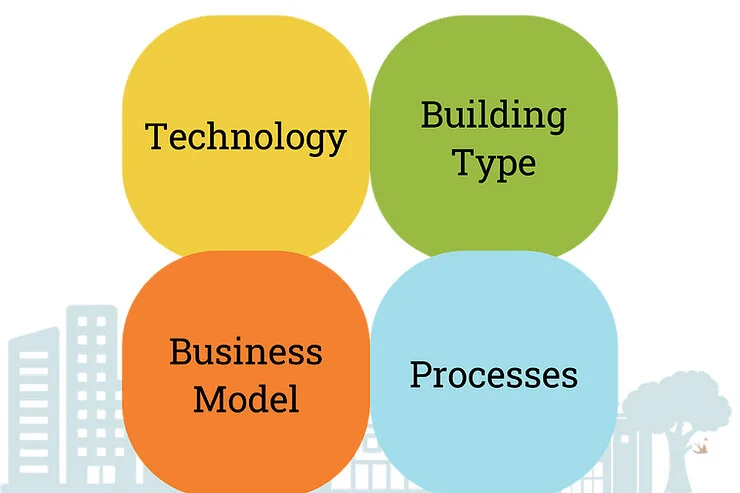Factors to Consider when planning for a DAS
If you are planning for an Enterprise DAS for your building or campus, there are a few factors you need to consider. This article falls somewhere between a checklist and an abbreviated collection of recommendations that can guide you in your DAS journey.
There are 4 areas to consider:
Technology
Building
Budget and business Model
High-level deployment sequence and processes
Technology
DAS based on need:
The first question to ask is why does your organization need to have this DAS. What is the driver? We have deployed DAS in Universities where the main driver for the DAS was student safety. They were not too concerned about the high data rate - because they have an existing WiFi system. In other words, 5G is not on their road-map for the next couple of years. They just wanted a budget-DAS.
We have worked with hospitals that wanted to make sure that patients, visitors, nurses, and doctors have good signals to talk on the phone. They chose not to have mission-critical devices or communications dependant on cellular services.
We also have organizations that wanted to make sure reliable, high-speed connectivity is available. They also wanted to have 5G on their road map for IIoT (Industrial Internet of Things).
We have recently worked with a hospital, where multiple departments on the campus are moving into app-based administration. From patient admission to the scheduling of doctors and nurses were moving to apps, and the mobility of employees was a big driver.
CIO of a large organization we work with announced that cell phones are business-critical devices just like laptops. So this organization wanted to own its own multi-carrier DAS.
The need for DAS is evolving with business, and identifying this 'need' for both short-term and long-term is critical. The nature of the 'need' will have an impact on the design, and ultimately the budget for the DAS.
Once you know why you need the DAS, which one should you pick?
Following are the options you have:
Public Safety DAS
Cellular DAS
CBRS DAS and/or Private LTE Network
Converged network
Public Safety (PSDAS)
Cities are mandating first responder networks in a new building
Recommend a separate layer of PSDAS instead of integrating with cellular or CBRS DAS. PSDAS has a strict requirement of back-up power, a separate layer can help you manage the back-up power better.
Integrated cellular and public safety DAS can increase the point of failure. Learn more about Public Safety DAS.
Cellular DAS
Cellular DAS is what is traditionally referred to as DAS
If you just want to come up with a budget, read on. We have a few tips below.
Principal Challenge: bringing the signal source from Operators or Carriers (i.e., AT&T, Verizon, T-Mobile-Sprint). Earlier you act, better prepared you will be.
Carriers will not join if you don't have a carrier-grade DAS. What is a Carrier-Grade DAS?
The landscape is about to change: 5G and CBRS. How will 5G and CBRS change the DAS game? Contact us to know more.
CBRS
CBRS is called the 'band of innovation' for good reason. Holds a lot of promise. The CBRS device and gear eco-system are exploding.
3.5 GHz and 150 MHz. 150 MHz is huge. CBRS is similar to WiFi, except it will be for LTE and 5G (in the future).
3 tiers of users - Incumbent (mainly existing military users), PAL (prioritized for those who pay) and GAA (open to all)
PAL Auction on June 25, 2020. If you are interested to get your own CBRS frequencies for the next 10 years, this is the auction you need to keep your eyes on.
Converged Network:
DAS, WiFi, A/V, Security combined network.
Converged network market dominated by Corning
It makes better sense for mid-size buildings if one organizational body (e.g., IT) is in charge of all technologies. If you are about to construct a new building, you may want to check into this.
(Bonus Info) All-Fiber DAS:
Traditional DAS had been a mix of fiber and coaxial cable - also known as Active DAS. All-fiber DAS platforms are a relatively new entrant.
We recommend all-fiber DAS for cellular & CBRS (as opposed to traditional fiber & coax based DAS): Why? Consider upcoming 5G & CBRS technologies. Th lower loss with fiber will be better for future technologies.
Electronics cost can be higher compared to traditional active DAS but can be offset to some extent by reduced testing costs (Additional Sweep and PIM tests needed for coaxial cable for Hybrid DAS. All fiber-DAS will require mainly OTDR and Optical Loss Tests)
Building
New versus Old
Old building challenges:
We have to design around existing rooms and limited real estate to place the electronics. These building-specific factors drive up the cost of DAS.
Asbestos in older but renovated buildings may become an issue. Houses built between 1930 and 1950 may have asbestos as insulation. Asbestos may be present in textured paint and in patching compounds used on wall and ceiling joints. Their use was banned in 1977. (Source)
In existing hospitals, low voltage vendors may have to work with Infectious Control protocols and work around restricted areas such as surgical areas
Installers have to work around the human traffic inside the building. For example, in an existing hospital, vendors have to contend with patients, doctors, nurses, visitors, and staff.
New building challenges:
Building construction (hereafter, CX) takes precedence and dominates the schedule. Mainly Project Management and Management control issues.
Installed DAS can become damage prone because we don’t have much control over CX crew
Getting the final drawings in time to finalize the design (CX often keeps changing)
Funding challenges
Budget and Business Models
There are 2 options for developing a budget to deploy a DAS.
Budget Option1 | ROM for a typical building
Develop a rough order magnitude budget based on the floor layout of the intended coverage area, and forecasted user count.
ROM budget can be developed for new or existing buildings.
The ROM budget can include the price for electronics, passive materials, tests, and labor.
This budget can be developed in a relatively short amount of time (e.g., days), but...
The key phrase here is 'rough order'. If you must have a budget to start, you can opt for ROM. For a more accurate budget, see option 2.
Budget Option2 | Develop a more accurate budget for an existing building (note the exceptions for new buildings):
Collect benchmark data (this helps designers figure out the current signal profile of all carriers and engineers can also deduce DAS coverage goals by floor).
Electronics prices are usually the priciest component of the budget.
Get iBwave design completed and generate CX-ready documents
Develop Budget from CX-Ready documents.
Exception for new buildings:
Traditional Business Models of Integrators
Integrators will provide equipment from the preferred manufacturer (with 25%-40% mark-up)
Integrators will provide design, installation and commissioning services. They may or may not hire a local low voltage vendor (LVV), but the LVV becomes Integrator’s sub-contractor
This causes a higher cost for the customer compared to the option below.
Recommended Business Models to lower the cost
Vendor-neutral integrator picks a DAS platform based on customer’s need, engineering quality, and optimized cost
The customer buys equipment directly from the manufacturer. The integrator can help negotiate a discounted pricing - eliminate mark-up on equipment
Customer engages preferred low voltage vendor - eliminate the mark-up
Integrators provide design, equipment installation, and commissioning services.
High-level deployment sequence and processes
NEW BUILDINGS
DAS deployment approach (for new buildings) based on available funding:
#1 Full DAS funding is not available yet | Plan Ahead | Make Building DAS friendly:
Get the fiber plant design completed based on initial floor layout,
Install the fiber backbone and hybrid fiber plant,
Dedicate riser chase for DAS cable run,
Assign room for DAS head-end, make provision for power and HVAC and
Allocate space for electronics and additional power for DAS in selected IDF closets
Keep space on cable tray for DAS cables
#2 Full DAS funding is available but the building is not built yet
Give guidance to architects to make the building design DAS friendly
Notify local DAS engineers and program managers of the carriers about the upcoming DAS
Develop prelim iBwave design (based on floor plans) before the exterior walls go out. Preliminary design can help you in guiding fiber run and need for space in the building. If you get the preliminary iBwave design done, updating the design will be easier once the benchmark study is completed.
Conduct benchmark study as soon as the exterior walls go up
Finalize iBwave design and get CX-ready documents (floor layout with DAS devices, bill of materials, logical diagram, etc.)
Share design with carriers and start engagement with carriers
Order materials and start construction
EXISTING BUILDINGS
DAS deployment approach (for existing buildings) based on funding:
#1 Limited funds available:
Conduct benchmark data collection
Develop iBwave design and get CX ready documents
Communicate designs with carriers
#2 Full DAS funding is available:
Notify local DAS engineers and program managers of the carriers about the upcoming DAS
Conduct a benchmark study
Finalize iBwave design and get CX-ready documents (floor layout with DAS devices, bill of materials, logical diagram, etc.)
Share design and start engagement with carriers
Order materials and start construction





